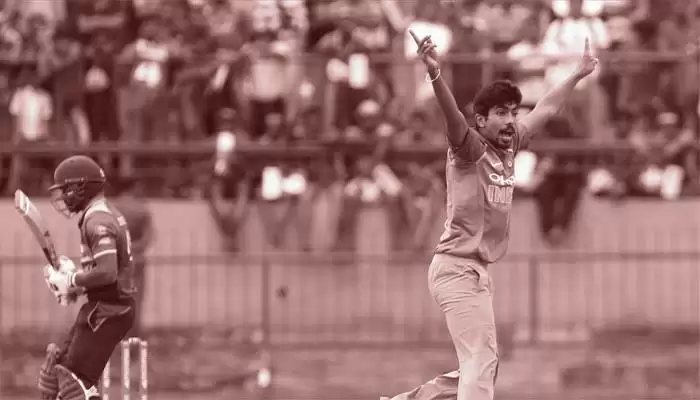
Jasprit Bumrah has gone from a T20 beast to a red-ball genius – a rapid metamorphosis from chalk to cheese – in the last couple of years so much so that in 2019, he played just two T20Is for India. But as he returns to take on India’s perennial whipping boys, the focus is naturally […]


Jasprit Bumrah has gone from a T20 beast to a red-ball genius – a rapid metamorphosis from chalk to cheese – in the last couple of years so much so that in 2019, he played just two T20Is for India.
But as he returns to take on India’s perennial whipping boys, the focus is naturally on him. BCCI’s twitter handle went out of their way to post a video of Bumrah shattering the stumps in a pre-series bowling session on the ground as a possible prelude to what Sri Lanka can expect in the series.
Missed this sight anyone?

How’s that from @Jaspritbumrah93 #TeamIndia #INDvSL pic.twitter.com/hoZAmnvE2k— BCCI (@BCCI) January 3, 2020
In the year of the T20 World Cup, Bumrah is likely to turn out a lot more for India in the format he first made a name in. Kick-starting New Year against a side whose top run-getter in 2019 in the format was a tail-ender (Isuru Udana) is just perfect for the Mumbai Indians seamer.
But, is there a way to handle T20 cricket’s most precious bowling commodity who is on a comeback trail after injury?
Bumrah’s T20I record for India makes for interesting viewing: 51 wickets in 42 T20Is at an average above 20 and an economy rate just above 6.
!function(){“use strict”;window.addEventListener(“message”,function(a){if(void 0!==a.data[“datawrapper-height”])for(var e in a.data[“datawrapper-height”]){var t=document.getElementById(“datawrapper-chart-“+e)||document.querySelector(“iframe[src*='”+e+”‘]”);t&&(t.style.height=a.data[“datawrapper-height”][e]+”px”)}})}();
Dissect the record by splitting his numbers against each opposition and you see that South Africa (admittedly with a low sample size of two matches), West Indies and Australia are the only teams to have scored at above 7 runs per over against him.
Of these, West Indies and South Africa have the better strike rate against Bumrah, but Australia have thrived on a set template against the seemingly unplayable Indian pacer and it’s a blueprint that Sri Lanka might want to have a glance at ahead of the first T20I at Guwahati.
Bumrah has played 11 T20Is against Australia in the format, leaking runs at 7.45. He has bowled a total of 40.3 overs against them in these matches. But let’s dig in deeper.
Of the 40 overs Bumrah has bowled at them, 24 have come inside the powerplay overs, which is a tad bizarre because we often see him labelled as a death overs bowler. Now, Bumrah in the death is a totally different beast and tackling him then could well come down to individual brilliance. But the same cannot be said of the powerplays.
Take a glance at his bowling in the powerplays against the Aussies: 194 runs in 24 overs at an economy rate of 8.08.
!function(){“use strict”;window.addEventListener(“message”,function(a){if(void 0!==a.data[“datawrapper-height”])for(var e in a.data[“datawrapper-height”]){var t=document.getElementById(“datawrapper-chart-“+e)||document.querySelector(“iframe[src*='”+e+”‘]”);t&&(t.style.height=a.data[“datawrapper-height”][e]+”px”)}})}();
Bumrah has reaped just three wickets in the powerplays against the Aussies and has gone at more than 7 runs per over in the powerplay overs on eight out of 11 occasions.
Now, there’s a general template to Bumrah’s new ball spells that often goes under the radar. A natural ability to skid the ball off the deck combined with a searing yorker in his repertoire often paints an image of a bowler who is full and fast.
On the contrary, Bumrah in the powerplays is neither here nor there. He tends to drift a lot onto the leg-side early on in his spell or finds extra bounce from a good length, thereby bringing the horizontal bat shots into play. On a lot of occasions, he also over-compensates with a really full ball, inviting the drive.
Of Australia’s top-order batsmen, Aaron Finch, Usman Khawaja and Shane Watson have in particular done well against Bumrah in the shortest format.
Finch – 58 in 43 balls with 8 fours
Khawaja – 29 in 9 balls with 6 fours
Watson – 22 in 18 balls with 2 fours
All three have a common characteristic – they bludgeon pull shots, but are equally good on the drive. David Warner, another excellent horizontal bat player, has struggled against Bumrah for Australia but has had success in the IPL with a similar template.
The pattern is striking. In the powerplays, Bumrah is a bit off his radar a lot of times, but teams are often circumspect to start off with given his reputation and he gets away. A lot of players who have had success against him early on are generally aggressive batsmen who go for their shots.
Refer to Evin Lewis’ onslaught of him at Lauderhill in 2016 or Khawaja’s aggression at the top in a 17-run opening over at Mohali three years back, and you see that Bumrah does err and batsmen who take him on early on are rewarded.
Sri Lanka played around with their top-order in Pakistan and Australia despite them winning the first series 3-0. But their ideal top-order needs to have Danushka Gunathilaka, Avishka Fernando and Bhanuka Rajapaksa in that very order.
The advantage these three have is that while Gunathilaka is naturally aggressive, Fernando and Rajapaksa are striking timers of the ball and latch onto anything too full or short. Sri Lanka are likely to get a lot of full balls or deliveries that rise up off a length in the beginning from Bumrah (and possibly Navdeep Saini).
Riding the bounce and playing shots come naturally to these players as they gauge the length pretty quickly. In Kusal Mendis and Kusal Perera they have two other fine players of pace and if they do want to blood Perera, a fine player with a good range of horizontal bat strokes, in the top three at the expense of Fernando or Rajapaksa, it won’t be too bad a move either.